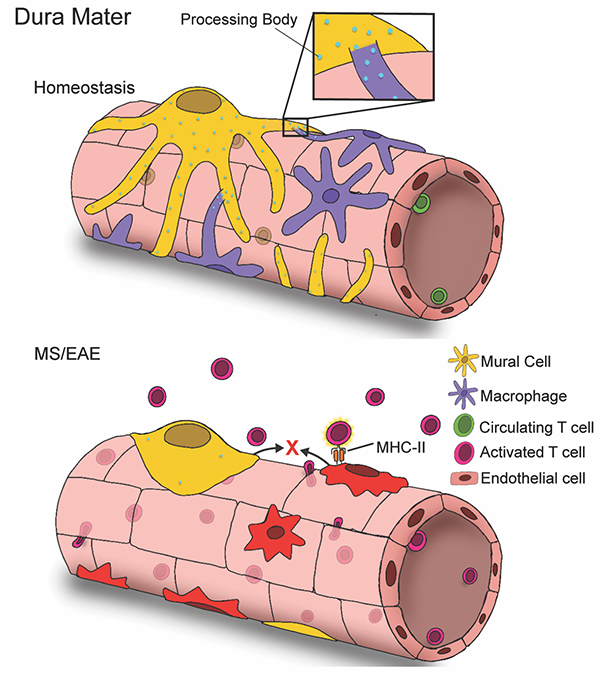
In a study out today, Duke researchers describe a newly discovered interaction of two specialized cells in the protective covering of the brain (dura). This interaction—between mural cells and macrophages— controls the movement of immune cells that target the central nervous system (CNS) and may be important in driving CNS autoimmune diseases like multiple sclerosis.
“The immune system and the CNS have an intricate relationship, where they must continuously interact to maintain healthy brain function,” says Anthony Filiano, PhD, assistant professor in the Department of Neurosurgery at Duke University School of Medicine and senior author of the paper. “Yet, the CNS must maintain a level of tolerance to immune cells, avoiding an overreaction to that could lead to the development of autoimmune disease. When tolerance is broken, such as in multiple sclerosis, it is thought that T cells can infiltrate the CNS through the meninges to cause destruction of myelin and ultimately neurodegeneration.”
In the lab, Filiano and colleagues found that mural cells physically connected with macrophages in the protective covering of the brain (the dura mater) and shared information that is packaged in an organelle called processing bodies. Macrophages that received this information underwent a change that prevented the activation of a harmful autoreactive population of T cells.
“Overall, our study may explain triggers initiating early pathogenic events in multiple sclerosis,” said Filiano.
The study was published January 9, 2024, in the Journal of Experimental Medicine. In addition to Filiano, authors include: Hyunjung Min, PhD, Dept. of Neurosurgery; Shane O’Neil, PhD, and Li Xu, MS, Marcus Center for Cellular Cures; Ashley Moseman, PhD, Dept. of Integrative Immunobiology; and Joanne Kurtzberg, MD, director of the Marcus Center for Cellular Cures.
This work was supported by grants from the National Institutes of Health (NS123084) and grants from the Hartwell Foundation, the Cord Blood Association Foundation, and the Marcus Foundation.